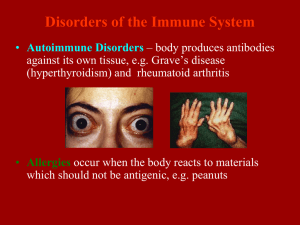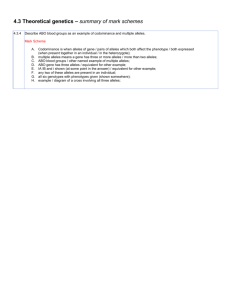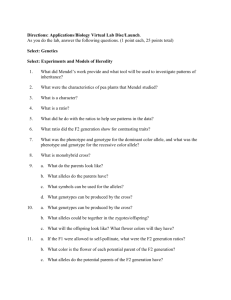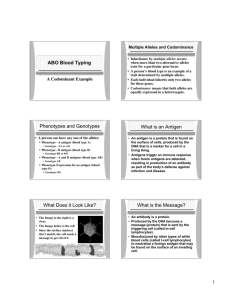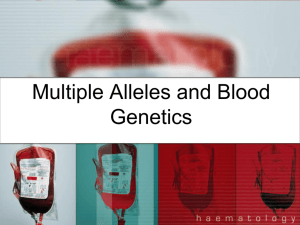Blood Types - David Colarusso
advertisement
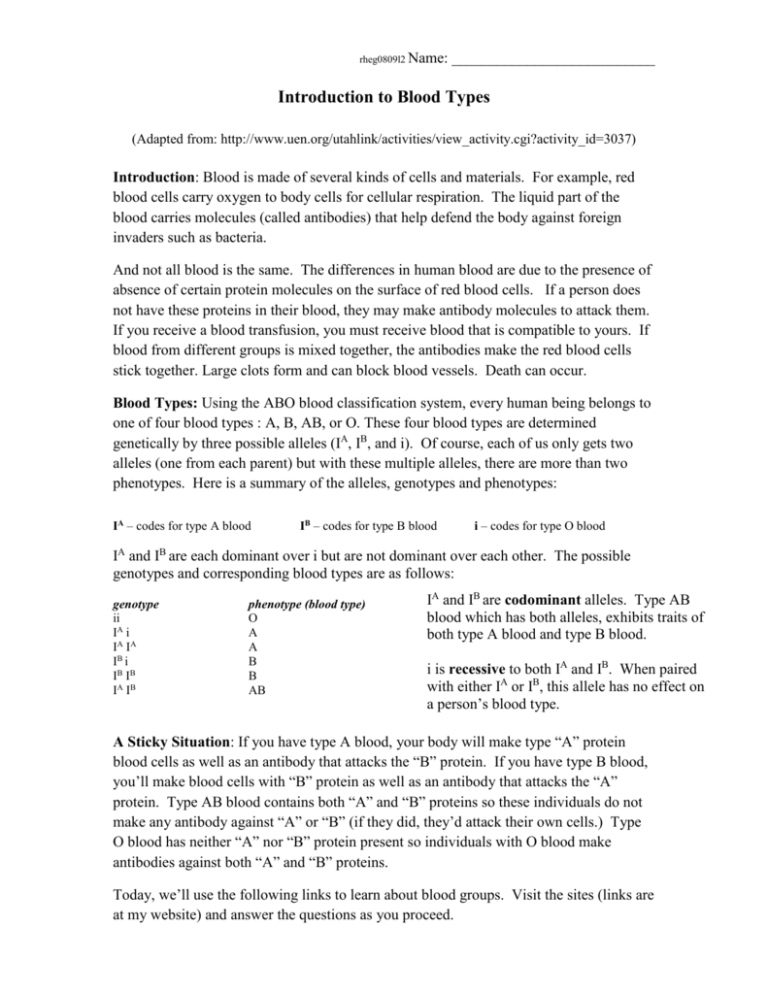
rheg0809l2 Name: ___________________________ Introduction to Blood Types (Adapted from: http://www.uen.org/utahlink/activities/view_activity.cgi?activity_id=3037) Introduction: Blood is made of several kinds of cells and materials. For example, red blood cells carry oxygen to body cells for cellular respiration. The liquid part of the blood carries molecules (called antibodies) that help defend the body against foreign invaders such as bacteria. And not all blood is the same. The differences in human blood are due to the presence of absence of certain protein molecules on the surface of red blood cells. If a person does not have these proteins in their blood, they may make antibody molecules to attack them. If you receive a blood transfusion, you must receive blood that is compatible to yours. If blood from different groups is mixed together, the antibodies make the red blood cells stick together. Large clots form and can block blood vessels. Death can occur. Blood Types: Using the ABO blood classification system, every human being belongs to one of four blood types : A, B, AB, or O. These four blood types are determined genetically by three possible alleles (IA, IB, and i). Of course, each of us only gets two alleles (one from each parent) but with these multiple alleles, there are more than two phenotypes. Here is a summary of the alleles, genotypes and phenotypes: IA – codes for type A blood IB – codes for type B blood i – codes for type O blood IA and IB are each dominant over i but are not dominant over each other. The possible genotypes and corresponding blood types are as follows: genotype ii IA i IA I A IB i IB IB IA IB phenotype (blood type) O A A B B AB IA and IB are codominant alleles. Type AB blood which has both alleles, exhibits traits of both type A blood and type B blood. i is recessive to both IA and IB. When paired with either IA or IB, this allele has no effect on a person’s blood type. A Sticky Situation: If you have type A blood, your body will make type “A” protein blood cells as well as an antibody that attacks the “B” protein. If you have type B blood, you’ll make blood cells with “B” protein as well as an antibody that attacks the “A” protein. Type AB blood contains both “A” and “B” proteins so these individuals do not make any antibody against “A” or “B” (if they did, they’d attack their own cells.) Type O blood has neither “A” nor “B” protein present so individuals with O blood make antibodies against both “A” and “B” proteins. Today, we’ll use the following links to learn about blood groups. Visit the sites (links are at my website) and answer the questions as you proceed. What's Your Type? http://sln.fi.edu/biosci/blood/types.html 1. Who was the first person to recognize the ABO system of grouping blood? How did he figure it out? 2. People of what blood type are universal donors? Why? 3. People of what blood type are universal receivers? Why? Are You Positive Or Negative? http://sln.fi.edu/biosci/blood/rh.html 1. What does it mean if your blood type is AB+? 2. What does it mean if your blood type is O-? 3. Why is the Rh factor important for pregnant women? Human Blood Types Reference http://www.ucs.louisiana.edu/~bkd3019/blood.html 1. 2. What is the most common human blood type? What is the least common? Blood Types Tutorial : How Are ABO Alleles Inherited By Our Children? http://www.biology.arizona.edu/human_bio/problem_sets/blood_types/inherited.html An allele is an alternate form or variety of a gene. Each biological parent donates one of their two ABO alleles to their child. Use Punnett Squares to answer the following questions then scroll down the page to the blood type calculator and use it to check your answers. 1. If one parent has blood type A and the other parent has type B, what are the 4 possible blood types for their children? 2. If one parent is type A and the other parent is type A, what are the possible blood types of their children? 3. If one parent is type A and the other parent is type O, what are the possible blood types of their children? 4. If one parent is type A and the other parent is type AB, what are the possible blood types of their children? Blood Types Problem Set http://www.biology.arizona.edu/human_bio/problem_sets/blood_types/blood_types.html There are 6 possible scenarios of individuals solving blood type puzzles. See how you do. You can compare your answers to those of the blood type expert. Blood Typing Interactive Game http://nobelprize.org/educational_games/medicine/landsteiner/index.html Play this interactive game to see if you can use your knowledge of blood typing to save three patients. Read the directions before you begin. Genotype Phenotype ++ Rh positive +Rh positive -Rh negative


